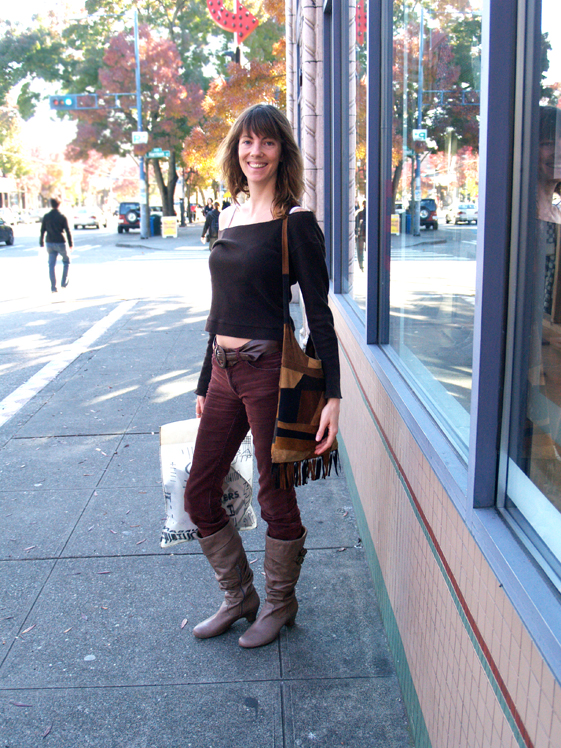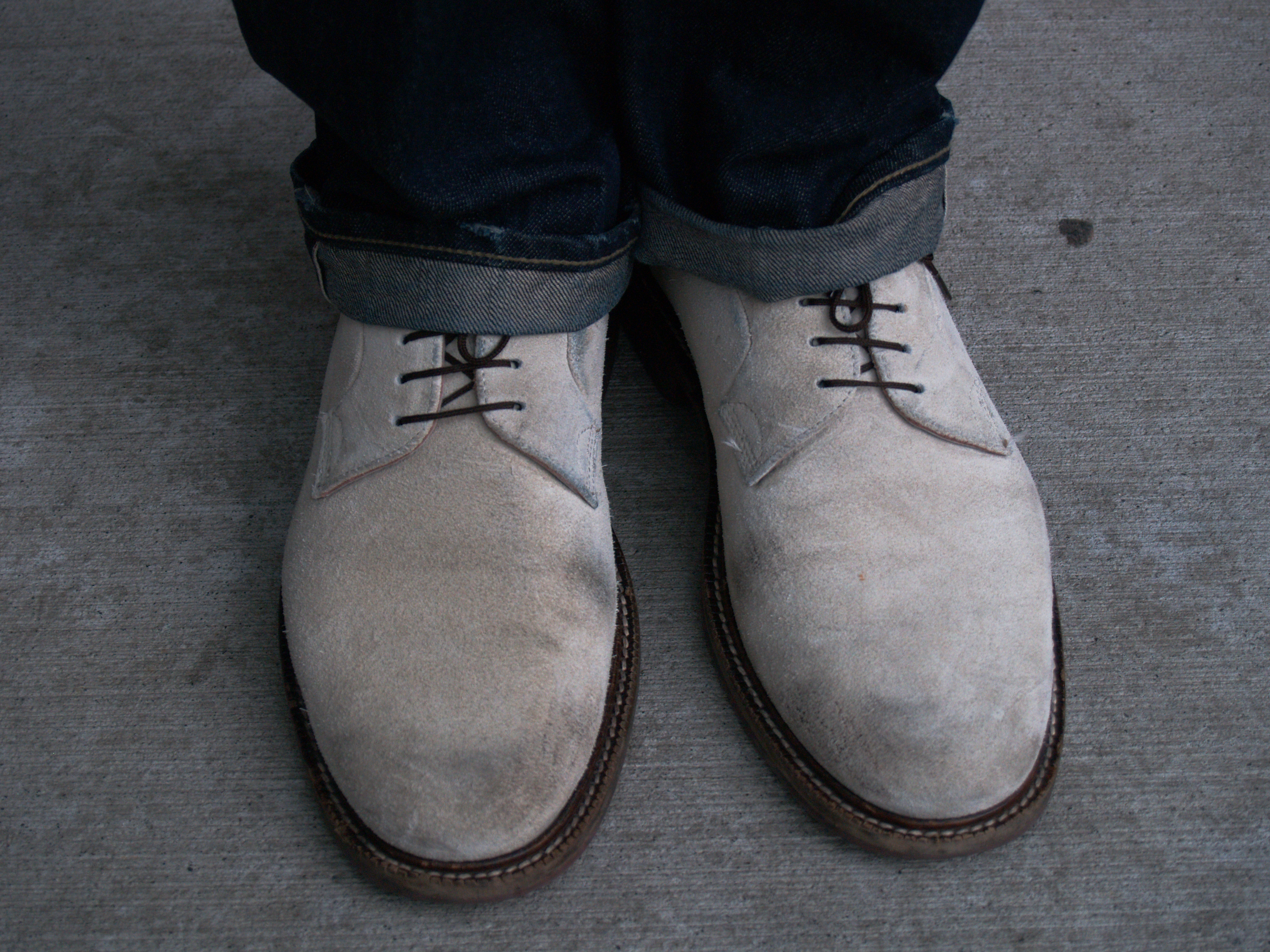Sarah Trudeau is an eco-chic goddess. We loved her effortless bohemian style and were ecstatic to discover that most of her outfit supports local fashion, both in Seattle and abroad. Her shoes were purchased at local West Seattle shop Edie’s Shoes, and are available in navy, olive green, and this lovely taupe color. Her shirt was a special find in Nepal, handcrafted by an American designer living abroad who was selling her garments in the back of a local shop. Her purse has a similar story. It was found at a local shop in India.
Shirt: purchased in Nepal
Purse: purchased in India
Shoes: Edie’s Shoes, located in West Seattle
Pants: Urban Outfitters
While we’re on the topic, let’s discuss how to inject eco-friendly practices into your fashion regiment. Green fashion is more prevalent than ever. At one point it was typical to sacrifice style in order to support the eco-friendly fashion initiative. However, more and more designers are implementing green fashion practices into their designs and construction. Being eco-chic is possible, you just need to know the facts. Here we provide you some tips for supporting green fashion, and how you can implement it into your wardrobe.
1. Pay Attention to Where Clothing and Accessories are Made. Don’t ignore that “Made In” verbiage on clothing tags and packaging. Aside from the benefit of supporting local materials and designers, it gives you insight into the energy wasted to transport that one item. The further away it’s made, the larger the carbon footprint of that product.
2. Buy Second-Hand, Vintage, and Recycled Styles. The longer the life line of a garment, the less time it will spend in landfills. Someone else’s garbage is another person’s treasure, so remember to donate your old styles as well. Feeling crafty? Put your own spin on old items and refurbish old styles to create a new, DIY look.
3. Avoid Purchasing Items That Require Intensive Care, such as Dry Cleaning. Many dry cleaners use harsh chemicals and methods to wash clothing. If you need to use a dry cleaner, seek out one that is sustainable. If funds permit, seek out an Energy Star washer and dryer, which can save gallons of water a year. Be wary of clothing that advertise low-maintenance features, such as “wrinkle free.” These often use harmful chemicals that are bad for the environment.
4. Know What terms like “Organic” and “Fair Trade” Mean. To be 100% organic, items need to be certified by a recognized third party (such as the USDA) and must follow strict guidelines for growing fibers and avoiding all synthetic materials. Fair trade garments are produced with the whole process in mind, rather than just the final product. This often entails personal relationships with suppliers, ensuring fair working conditions and compensation. Sustainable fashion refers to an item that can be produced over and over again without affecting the environment. Cruelty-free means that a company does not use or test products on animals. Keep track of this type of wording, especially as it pertains to your favorite brands. Research the companies you purchase from most and become familiar with their manufacturing practices and policies.
5. Buy Clothing Made of Sustainable Fabrics. These include fabrics such as bamboo, linen, organic cotton, soy, and wool. There are even more scientifically advanced, sustainable fabrics, such as SeaCell (seaweed and wood pulp) and Eco-Spun (recycled soda cans and bottles). Avoid fabrics that don’t use natural dyes. Dyeing fabrics uses more water than most industries. Also, consider reducing the amount of animal products in your wardrobe, such as leathers and furs.
6. Practice Mindful Consumption. Embodying eco-chic fashion reminds us of the old adage of sexual abstinence, don’t buy (have sex), don’t waste (get pregnant/STDs). In theory it is best to only buy what you need and don’t go on excessive and lavish shopping sprees. However, we know being fashion-obsessed can make this difficult to follow. A good compromise is to try and go easy on the trends, injecting classic pieces into your wardrobe that will never go out of style. This extends the life of your clothing, making it less likely you will dispose of last season’s looks.
7. Implement Green Practices into your Beauty Regiment. Use organic and natural beauty products in addition to supporting sustainable fashion. This includes purchasing paraben and cruelty-free products, and paying attention to ingredient lists. If you can’t pronounce the ingredient, or it has words ending in scientific terms such as “-ide,” skip it. Not only does it protect the environment, but you are also protecting yourself, since many experts believe ingredients and chemicals used in traditional beauty products can cause cancers.
8. Make Sure Your Complementary Fashion Necessities are Eco-Friendly. This includes using sustainable hangers and biodegradable detergents. Also, avoid bleach (use “green bleach” alternatives) and try using natural stain removers before purchasing chemically-laden stain fighters. Oh, and did we mention investing in eco-friendly washer and dryer appliances? Besides reducing water consumption, it reduces your bills. Gotta save them dollars where you can.
9. Stop Making Excuses. The #1 excuse for supporting anything eco-friendly relates to money. Whether it’s food, automobiles, or fashion, people like a deal and, let’s face it, organic usually implies “$$$.” However, don’t think about the immediate gratification of saving a few bucks, but rather look at the bigger picture. Think of all the good you are doing, and try to understand that paying a little more goes a long way in the end. Another common argument is that eco-friendly fashion isn’t as stylish as traditional designs. Sure, “traditional fashion” has been around a lot longer, so yes, there are more options. But there are a plethora of new brands popping up, serving the demand for eco-chic fashion. Do your research and look for sustainable versions of an item you’re coveting, rather than simply deeming finding a green version unlikely.
10. Speak Up. We’re not suggesting you be a political advocate for all things green (though if you did that, that would warrant you a gold-star of awesomeness). We’re just suggesting you speak out when the opportunity presents itself. Store owners are dedicated to serving their customers, so if enough people demand eco-friendly fashion alternatives, they will most likely comply. And remember, actions speak louder than words, so implement green fashion practices into your everyday life. Repeat after us: “Practice what you preach.”
We hope this helps you on your path to supporting sustainable fashion. If you have any other suggestions, be sure to bring them up in the comments. We look forward to hearing your ideas!


I LOVE this!!
It reminds me of a great/funny book I read ‘The Eco Chick Guide to Life: How To Be Fabulously Green!’ It has a ton of great practices and links to living a green life.
I think it’s really important that you do research into what those terms mean on the labels of your clothes and in your foods/products. Just because something sounds natural, does not guarantee that it is! The more aware everyone becomes, the more companies will change their policies.
Here is a link to the book if anyone is interested..
http://www.amazon.com/Eco-Chick-Guide-Life-Fabulously/dp/0312378947
It includes some great websites, like:
http://www.enamore.co.uk
http://www.charmone.com
:]
Amy, thank you for the book suggestion. We will be sure to check it out. We totally agree that the regulations for notifying consumers of organic and natural products are a little hazy. It is definitely important for us to be conscientious when we do our shopping. Reading labels isn’t always necessarily enough. That is why we suggested researching the practices of your favorite brands, so you can stay more informed. We look forward to hearing more of your thoughtful comments 🙂
Helpful blog, bookmarked the website with hopes to read more!